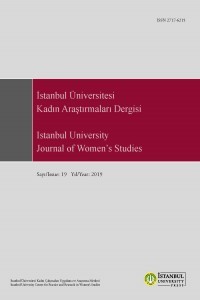Snow White in Early 21 st c. Dance Performances: Subverting Fairy-tale Female Models
Snow White in Early 21 st c. Dance Performances: Subverting Fairy-tale Female Models
Snow White, Dance, Intersectional Feminism, Fairy-Tales Contemporary Dance,
___
- Addict Initiative (hip-hop dance crew). (2014). Snow White [performance video]. UK: ITV. Retrieved from https://www.youtube.com/watch?v=fnHyQExwE7A .
- Anonymous (2014). Barbe-Neige et les sept petits cochons au bois-dormant (Snow-Beard and the seven little piglets in the sleeping-forest). In dance platform Numeridanse.tv [Web page]. Retrieved from https://www.numeridanse.tv/en/dance-videotheque/barbe-neige-et-les-sept-petits-cochons- au-bois-dormant Accessed 1 February 2023.
- Aristotle (2021[1912]). On the Generation of Animals. (A. Platt, Trans.). Glasgow: Good Press.
- Bacchilega, C. (1988). Cracking the Mirror Three Re-Visions of ‘Snow White’. Boundary 2, vol. 15/16, 1–25. https://doi.org/10.2307/303243. Accessed 2 February 2023.
- Bettelheim, B. (2003). Psychanalyse des contes de fées [Psychoanalysis of fairy-tales]. Paris, France: Robert-Laffont.
- Bettelheim, B. (2010). The Uses of Enchantment: the Meaning and Importance of Fairy Tales, New York, NY: Vintage Books
- Birkhüser-Oeri, S. & von Franz, M.-L. (2014). La mère dans les contes de fées [The mother in fairy- tales]. (M. Bacchetta, Trans.). Paris: La Fontaine de Pierre.
- Calasanti, T. et al. (2006). Ageism and Feminism: From ‘Et Cetera’ to Center.”. NWSA Journal, vol. 18, no. 1, 13–30. http://www.jstor.org/stable/4317183. Accessed 2 February 2023.
- Crenshaw, K. (2023). On Intersectionality. Essential writings. New York: The New Press. Delap, L. (2020), Feminisms. A Global History. London: Pelican.
- Jackson, S. J., Scherer J., & Héasm S. (2007). Sports et performances indigènes: le Haka des All Blacks et les politiques identitaires en Nouvelle-Zélande [sports and indigenous performances: the Haka of the All Blacks and New-Zealand identity politics]. In Corps, vol. 2, no. 1, 43-48. https://www.cairn.info/revue-corps-dilecta-2007-1-page-43.htm. Accessed 10 January 2023.
- Jevons, R. (2016, March 14). Liv Lorent on balletLORENT’s Snow White. The State of the Arts. [Web page] Retrieved from https://www.thestateofthearts.co.uk/features/liv-lorent-balletlorents- snow-white/. Accessed 31 January 2023.
- Humphrey, D. (1987). The art of making dances, Trenton, NJ: Princeton Book Co.
- Loureiro, A. & Cottin, R. (2012). Le conte de fées comme partition corporelle. L’impulsion d’envoûtement dans l’effort de Rudolf Laban [The fairy-tale as body partition. The impulse of enchantment in Rudolf Laban’s ‘effort’]. Repères, cahier de danse, vol. 30, no. 2, 29-31.
- Marquié, H. (2016). Non, la danse n’est pas un truc de filles ! : essai sur le genre en danse [No, dancing is not a girl thing!: essay on gender in dance]. Toulouse, France: Éditions de l’Attribut.
- Propp, V. (1970). Morphologie du conte [Morphology of the fairy-tale]. Paris: Édition du Seuil.
- Rettl, L. (2001). Fairy Tales Re-Visited. Gender Concepts in Traditional and Feminist Fairy Tales. AAA: Arbeiten Aus Anglistik Und Amerikanistik, vol. 26, n°2, 181–98. http://www.jstor.org/ stable/43025615. Accessed 2 February 2023.
- Romero, M. (2018). Introducing Intersectionality. Medford: Polity Press.
- Schnitzer, L. (1995). Ce que disent les contes [What fairy-tales say]. Paris: Édition du Sorbier. von Franz, M.-L. (2015). La femme dans les contes des fées [Women in fairy-tales]. Paris: Albin Mitchel.
- von Franz, M.-L. (2016). Les modèles archétypiques dans les contes de fées [Archetypical models in fairy-tales]. Paris: La Fontaine de Pierre.
- Yayın Aralığı: Yılda 2 Sayı
- Başlangıç: 2019
- Yayıncı: İstanbul Üniversitesi
Transgressive Gestures in the Couple Dance in a Central-Transylvanian Local Community
Maria Gabriela LÓPEZ-YÁNEZ, Beatriz HERRERA CORADO
Black Women of The Cakewalk: Reclaiming The Performance Through Corporeal Orature
Women-Made – the Future Women Choreographers are Here!
Reverse-Engineering the Sylph: Reclaiming Female Ballet Bodies in Florentina Holzinger’s TANZ
Introduction by the Guest Editors of This Issue
Snow White in Early 21 st c. Dance Performances: Subverting Fairy-tale Female Models
